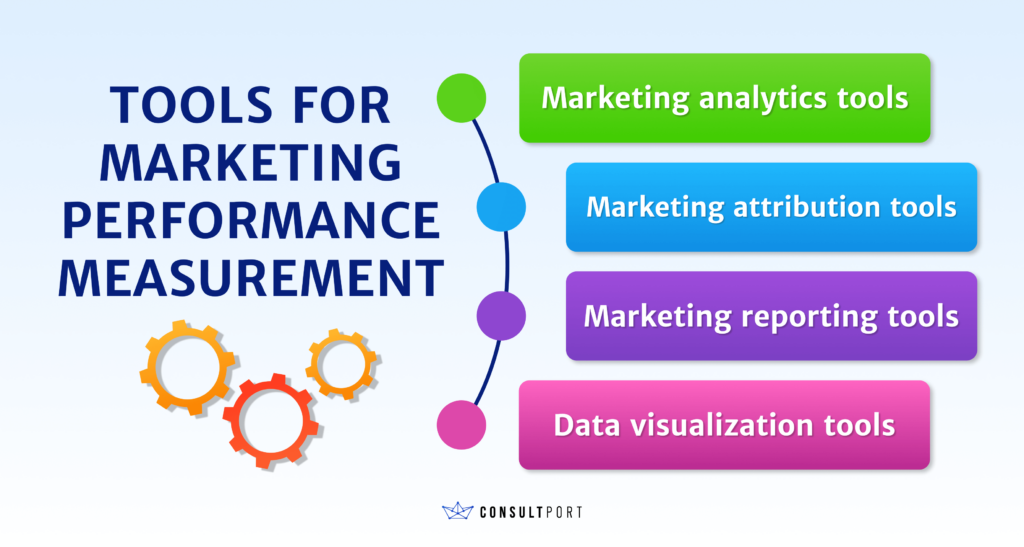Revamping 2024 Strategy: Essential Tools for Measuring Marketing Performance
Blog Categories:
Published:
January 22, 2024
Reading Time:
7 minutes

Measuring marketing performance has been a central issue for marketing managers and the company's management.
The explosion of digital channels and the development of marketing automation also sparked the interest in and the importance of understanding how effective marketing strategies are. Therefore designing, managing, and measuring marketing performance has become increasingly important.
A majority of marketing professionals use marketing performance tools to measure the effectiveness of their campaigns and identify areas for further improvements. HubSpot reports that only less than 25% of marketers fail to report how campaigns impact their company’s revenue.
According to the Forbes Marketing Accountability Report, marketers who invest more in measuring and managing marketing performance create more value. They achieve 5% better returns on marketing investments and more than 7% higher levels of growth performance, the report said. In an uncertain and digitally driven economy, marketing has a significant contribution to enterprise value with some cases reaching over 50%, it pointed out.

In this blog post, Consultport delves into the key metrics and updated tools for measuring marketing performance that every company must grasp in 2024.
The explosion of digital channels and the development of marketing automation also sparked the interest in and the importance of understanding how effective marketing strategies are. Therefore designing, managing, and measuring marketing performance has become increasingly important.
A majority of marketing professionals use marketing performance tools to measure the effectiveness of their campaigns and identify areas for further improvements. HubSpot reports that only less than 25% of marketers fail to report how campaigns impact their company’s revenue.
According to the Forbes Marketing Accountability Report, marketers who invest more in measuring and managing marketing performance create more value. They achieve 5% better returns on marketing investments and more than 7% higher levels of growth performance, the report said. In an uncertain and digitally driven economy, marketing has a significant contribution to enterprise value with some cases reaching over 50%, it pointed out.

In this blog post, Consultport delves into the key metrics and updated tools for measuring marketing performance that every company must grasp in 2024.
KEY TAKEAWAYS
- Marketers who pursue higher levels of marketing performance accountability achieve higher returns on marketing investments.
- Key metrics for measuring marketing performance include return on investment, conversion rate, cost per lead, and customer lifetime value.
- Among the most popular marketing performance measurement tools, Google Analytics is considered the best for companies who look for insights into website performance.
- A good marketing performance tool should be easy to manage, affordable, enable team collaboration, and allow firms to integrate with other tools.
Key Metrics for Measuring Marketing Performance
One of the challenges for firms in measuring marketing performance is that there are many ways to assess the performance. Key metrics include:
This is an excellent executive-level metric to measure the effectiveness of marketing strategies.

It refers to the measurement of how much profit and revenue growth is attributed to marketing activities.
Calculating return on marketing investment helps organizations measure how much the marketing efforts contribute to revenue in a holistic way or on a campaign basis.
It is a good indicator to measure the success of a campaign and can serve as a reference for future marketing activities. Measuring ROI also allows marketing professionals to form a baseline to adjust their efforts to maximize the impacts of marketing strategies.
It is also used to justify the allocation and distribution of budget for marketing activities.
However, to have a precise evaluation of marketing ROI, firms need to consider various factors, according to Marketing Evolution. Firstly, firms need to have a “clear and consistent” baseline for marketers to measure against. Secondly, it is important to take into account the external factors that affect the success of a marketing campaign, including weather, seasonal trends, and events, according to Marketing Evolution.
Marketing ROI = (Revenue generated by marketing campaigns - Marketing Expenses)/Marketing Expenses*100.
This tool is especially useful for measuring the effectiveness of online campaigns. Marketers can monitor conversion rates with marketing tools like Google Analytics and website analytics providers.
Tracking the conversion rate regularly can help businesses identify room for improvement, from which it can increase revenue and customer engagement.
The conversion rate = Total number of visitors/number of completed actions * 100.

The low cost per lead indicates that customers spend more money purchasing the products than the business spends on obtaining new customers. It also shows that the marketing strategies are cost-effective and the company is gaining profits.
Cost per lead = The amount spent/Leads generated.
Once businesses determine the amount of money a consumer is willing to spend on them, they can determine the amount of spend for marketing campaigns.
For example, a company calculates that a customer spends an average of 2,000 on its business over time. As this amount is relatively large, the company has the budget to increase spending on advertising and marketing campaigns. There is also room to invest more to offer a personalized email marketing strategy or content strategy.
According to Forbes, four key steps to calculate CLV include: determining the average order value, identifying the frequency of transactions, measuring customer retention, and calculating CLV.
CLV = average order value × number of transactions × average length of the customer relationship (in years).

They should also choose tools that can integrate well with other sales and marketing tools that the company is using. If the company has many teams sharing the same dataset, it should choose a tool that allows team collaboration.
Now let’s explore some of the popular tools that companies use for measuring marketing performance:
Many even consider this as the “industry standard” for evaluating the performance of the website. Companies can use website data to direct their marketing efforts and identify KPIs for the marketing team.
With Google Analytics, marketers know who the visitors to their website are, when they visit and what they do with the website. They can also have a grasp of the impacts of marketing campaigns and how user experience may influence factors including conversion and audience engagement and retention. A survey by HubSpot showed that Google Analytics is the top SEO tool used by marketers.

The tool offers hundreds of metrics and dimensions to support decision-making. The essential metrics for marketers include:
Its strengths include keyword discovery, search engine presence, and rank tracking. Its outstanding features include auditing tools that enable marketers to identify technical SEO and content optimization. With its keyword research features, marketers can find out the keywords that consumers use and navigate where the company ranks in terms of search engine results.
This tool also allows integration with other business applications and platforms like AgencyAnalytics, DashThis, Databox, Desktop.com, Google Search Console, Klipfolio, Marketing Miner, Rambox, Rank Ranger, Reportz.
Its standout features include gathering rich and actionable insights through tools such as heatmaps, surveys, and conversion funnels. It also records audience sessions therefore, marketers can have a firsthand view of user experience. Its easy-to-use platform is both time and money-saving.
The tool allows integration with third-party tools such as Google Analytics, Google Optimize, HubSpot, Microsoft Teams, Mixpanel, Omniconvert, Optimizely, Segment, and Slack.
The advantages of this tool include an insight into how to improve a website, being user-friendly and easy to use.
Return on Investment (ROI)
The ROI metric has been a “staple” in business for a long time, according to Forbes. In marketing, it is used as a metric to measure the value of marketing campaigns/efforts and help businesses make decisions about resource allocation, it said.This is an excellent executive-level metric to measure the effectiveness of marketing strategies.

It refers to the measurement of how much profit and revenue growth is attributed to marketing activities.
Calculating return on marketing investment helps organizations measure how much the marketing efforts contribute to revenue in a holistic way or on a campaign basis.
It is a good indicator to measure the success of a campaign and can serve as a reference for future marketing activities. Measuring ROI also allows marketing professionals to form a baseline to adjust their efforts to maximize the impacts of marketing strategies.
It is also used to justify the allocation and distribution of budget for marketing activities.
However, to have a precise evaluation of marketing ROI, firms need to consider various factors, according to Marketing Evolution. Firstly, firms need to have a “clear and consistent” baseline for marketers to measure against. Secondly, it is important to take into account the external factors that affect the success of a marketing campaign, including weather, seasonal trends, and events, according to Marketing Evolution.
Marketing ROI = (Revenue generated by marketing campaigns - Marketing Expenses)/Marketing Expenses*100.
Conversion rate
The strong development of digital marketing has paved the way for tracking conversion rates. It demonstrates how well the marketing strategies are doing and measures how many of the leads convert into sales, sign-ups.This tool is especially useful for measuring the effectiveness of online campaigns. Marketers can monitor conversion rates with marketing tools like Google Analytics and website analytics providers.
Tracking the conversion rate regularly can help businesses identify room for improvement, from which it can increase revenue and customer engagement.
The conversion rate = Total number of visitors/number of completed actions * 100.

Cost per lead
This metric helps businesses measure the amount of money they spend to generate each lead for the sales team.The low cost per lead indicates that customers spend more money purchasing the products than the business spends on obtaining new customers. It also shows that the marketing strategies are cost-effective and the company is gaining profits.
Cost per lead = The amount spent/Leads generated.
Customer lifetime value (CLV)
CLV refers to the amount of money that customers are likely to spend on a product or service. A good understanding of CLV will help businesses identify the amount of investment they need to acquire and retain customers.Once businesses determine the amount of money a consumer is willing to spend on them, they can determine the amount of spend for marketing campaigns.
For example, a company calculates that a customer spends an average of 2,000 on its business over time. As this amount is relatively large, the company has the budget to increase spending on advertising and marketing campaigns. There is also room to invest more to offer a personalized email marketing strategy or content strategy.
According to Forbes, four key steps to calculate CLV include: determining the average order value, identifying the frequency of transactions, measuring customer retention, and calculating CLV.
CLV = average order value × number of transactions × average length of the customer relationship (in years).
Key Tools for Measuring Marketing Performance in 2024
There are many different types of marketing performance measurement tools. Most of them aim to give users insights into the effectiveness of their marketing activities and support decision-making. Performance tools are often categorized as follows but are not limited to:- Marketing analytics tools: these are useful when the business runs a high-converting website. They help to track, measure, and report on the activity of the company’s website. The metrics include users, page views, bounce rates, and conversions, among others.
- Marketing attribution tools: these tools allow businesses to identify the marketing channels that are the most effective and have the biggest influence on business metrics.
- Marketing reporting tools: With these tools, marketers can collect and analyze metrics more easily. Businesses can also organize marketing data and insights in a more organized way before sharing them with clients and other stakeholders.
- Data visualization tools: these tools offer marketers an excellent solution to create visually attractive reports with insights for company executives and clients.

They should also choose tools that can integrate well with other sales and marketing tools that the company is using. If the company has many teams sharing the same dataset, it should choose a tool that allows team collaboration.
Now let’s explore some of the popular tools that companies use for measuring marketing performance:
Google Analytics
This is one of the most popular tools for marketing performance. Google Analytics gives businesses an insightful look at the performance of their website. With this tool, firms can measure how their marketing and content strategies are performing.Many even consider this as the “industry standard” for evaluating the performance of the website. Companies can use website data to direct their marketing efforts and identify KPIs for the marketing team.
With Google Analytics, marketers know who the visitors to their website are, when they visit and what they do with the website. They can also have a grasp of the impacts of marketing campaigns and how user experience may influence factors including conversion and audience engagement and retention. A survey by HubSpot showed that Google Analytics is the top SEO tool used by marketers.

The tool offers hundreds of metrics and dimensions to support decision-making. The essential metrics for marketers include:
- Audience: number of users and sessions, average session duration, average pages per session, ratio of new to returning visitors, bounce rate,...
- Acquisition: organic vs paid sessions, Google Ads, search console,...
- Behavior: newsletter opens, average time on page, top queries in search, top 10 landing pages, AdSense revenue,..
- Conversion: goal conversion rate.
Ahrefs
This tool is best for those who want to evaluate the effectiveness of competitor’s marketing campaigns.Its strengths include keyword discovery, search engine presence, and rank tracking. Its outstanding features include auditing tools that enable marketers to identify technical SEO and content optimization. With its keyword research features, marketers can find out the keywords that consumers use and navigate where the company ranks in terms of search engine results.
This tool also allows integration with other business applications and platforms like AgencyAnalytics, DashThis, Databox, Desktop.com, Google Search Console, Klipfolio, Marketing Miner, Rambox, Rank Ranger, Reportz.
Hotjar
This tool is best for companies that want to gain an insightful understanding of the way visitors experience websites.Its standout features include gathering rich and actionable insights through tools such as heatmaps, surveys, and conversion funnels. It also records audience sessions therefore, marketers can have a firsthand view of user experience. Its easy-to-use platform is both time and money-saving.
The tool allows integration with third-party tools such as Google Analytics, Google Optimize, HubSpot, Microsoft Teams, Mixpanel, Omniconvert, Optimizely, Segment, and Slack.
The advantages of this tool include an insight into how to improve a website, being user-friendly and easy to use.
Conclusion
Marketing performance measurement is key to enabling marketing accountability. Companies are becoming increasingly aware of the importance of having an appropriate measurement system for their marketing efforts.
It is now “more important than ever” for companies to link the impact of marketing efforts and financial investments to revenue and profit, according to the Definitive Guide to Marketing Metrics and Analytics.
It is also crucial to build a process for measuring marketing ROI. A Forrester study showed that 74% of high performers measure ROI, compared to 59% of low performers, the report said.
Whether your business aims to establish a new marketing performance measurement process or enhance your existing one, don’t hesitate to contact Consultport.
We have over 10,000 experienced freelance consultants in our network—all of whom have worked for blue-chip companies or top-tier consulting firms.
Our Marketing Performance Consultants will work alongside your marketing team to test the results of campaigns, both online and offline, and make changes to optimize the success of these campaigns.
It is now “more important than ever” for companies to link the impact of marketing efforts and financial investments to revenue and profit, according to the Definitive Guide to Marketing Metrics and Analytics.
It is also crucial to build a process for measuring marketing ROI. A Forrester study showed that 74% of high performers measure ROI, compared to 59% of low performers, the report said.
Whether your business aims to establish a new marketing performance measurement process or enhance your existing one, don’t hesitate to contact Consultport.
We have over 10,000 experienced freelance consultants in our network—all of whom have worked for blue-chip companies or top-tier consulting firms.
Our Marketing Performance Consultants will work alongside your marketing team to test the results of campaigns, both online and offline, and make changes to optimize the success of these campaigns.
Share This Story, Choose Your Platform!



